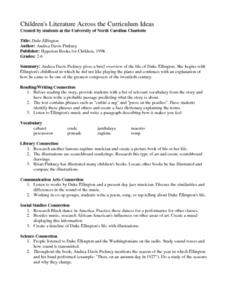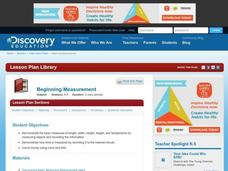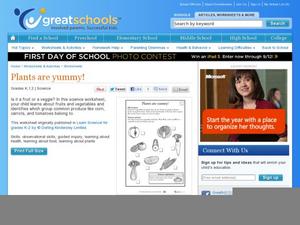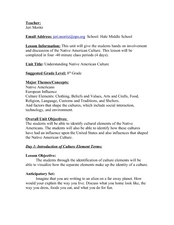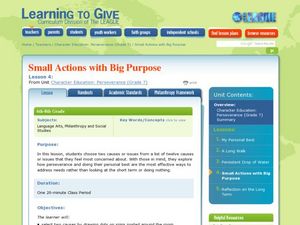Curated OER
Turtle Shell Craft
Have your class learn about turtles and adaptation using this lesson. Learners discuss turtles, the unique design of their shells, and the ways they have adapted to their surroundings. Then, they make a paper bag model to simulate a...
Curated OER
To Kill A Mockingbird: Characterization
Students analyze several of the characters from "To Kill a Mockingbird". They view segments of the film, create character webs based on the most revealing film scenes, write journal entries and participate in class discussion.
Curated OER
Peachy Teacup by the Stream
Help your kids distinguish between the sounds for short vowel /e/ and long vowel /e/. They are introduced to the vowel patterns that comprise long vowel sounds, with a particular emphasis on /ea/. They practice reading and spelling a...
Curated OER
Children's Literature Across the Curriculum Ideas-Duke Ellington
Pupils read Duke Ellington by Andrea Davis Pinkney. They complete a variety of cross-curricular activities surrounding the life of the 20th century composer. Included are reading, art, math, science, writing, social studies, and library...
Curated OER
Discovering Math: Beginning Measurement
Young mathematicians are shown a ruler, yardstick, tape measure and scale. They practice measuring length, width, height, and weight. They are then shown a thermometer, and discuss what a thermometer is used for. Everyone is shown how to...
Curated OER
What Lives in Water?
In this early childhood science worksheet set, students study the importance of water, and determine the difference between themselves and water dwellers. They look at adaptations, river life, rainforest life, food chains, pollution, and...
Curated OER
Acrostic Book Report
Pupils read the story Wild Horse Winter and construct acrostic poems. In this poetry lesson plan, students use adjectives and events in the text to develop an acrostic poem.
Curated OER
Past and Present
Providing an interesting way to discuss the U.S. presidency, this lesson has learners compare George Washington to the current president. They listen to books about George Washington, discuss the current president, and complete worksheets.
Curated OER
Computation with Fractions
Upper graders are introduced to the topic of fractions and percentages. In groups, they discuss real world situations in which fractions are present, and they complete a worksheet solving problems with common and uncommon denominators....
Curated OER
Plants are yummy!
Is it a fruit or a vegetable? Youngsters place an F next to each fruit they see and a V next to the vegetables. Corn is tricky. It is a grass, so it's actually not a fruit or a vegetable, but a grain!
Curated OER
Understanding Native American Culture
Ninth graders explore Native American culture. In this early Americans lesson, 9th graders will visit several stations around the room and examine native American artifacts then draw comparisons to other cultures. Students will then...
Curated OER
The Freedom to Fight
High schoolers study the African American troop experiences in the Civil War. In this American history lesson, students examine primary and secondary sources regarding the experiences and contributions of African American soldiers who...
Curated OER
Got a Problem? Let's Solve It! Lesson 1:
Students investigate how problem solving skills contribute to philanthropy. In this animal welfare lesson, students use problem solving skills to make suggestions about how to solve an issue regarding the humane treatment of an animal.
Curated OER
Partners for the Common Good: One Day
Fourth graders explore the concept of philanthropy. In this service learning lesson, 4th graders compare for profit and nonprofit organizations. Students explore nonprofit organizations in their community and discuss their philanthropic...
Curated OER
The World's Forests
Students examine the world's forests. In this forest lesson, students gain knowledge about the sustainability of forests. Students break into groups and brainstorm why forests are so important to our world. Students discuss...
Curated OER
Chicago: The City in Art, 1995-2000
Students examine a mural of animals and talk about animal classification. They act as scientists and keep a record, called a Jungle Journal, of plants and animals they observe while studying the rainforest.
Curated OER
For the Well-being of Our Citizens Lesson 2: Poverty And Human Rights
Young scholars investigate the definitions of poverty and impoverishment. They design a poster that show the Articles of the Universal Declaration of Human Rights that are violated by poverty. They write an article for the school...
Curated OER
Comparatively Speaking
Students practice creating similes and metaphors together as a class. Individually students create similes and metaphors and illustrate them.
Curated OER
Elements of a Mystery
Students write mystery stories. In this writing lesson, students review the definition and components of a mystery. They look at a photo and write a mystery to explain the picture.
Curated OER
Conflict in"the Interlopers"
Students read "the Interlopers" and define the four conflicts in the story. In this conflict lesson, students write an original story about three of the four conflicts in the book.
Curated OER
Pets
Students participate in an after school program that promotes making decisions, getting along with others, decision-making, and being responsible. A pet survey is administered along with a variety of pet riddles with the students. They...
Curated OER
Small Actions with Big Purpose
Seventh graders examine the trait of perseverance. For this character education lesson, 7th graders discuss community causes they care about and make plans to contribute their time and energy to overcome their personally-selected issues.
Curated OER
Simile and Metaphor Lesson Ideas
Teaching students about literary devices, such as simile and metaphor, can be a year long experience.
Curated OER
Monster Symmetry
Third graders understand what a line of symmetry is and how to draw symmetrically. In this monster symmetry lesson, 3rd graders create an original monster that is symmetrical. Students participate in additional symmetry activities.



